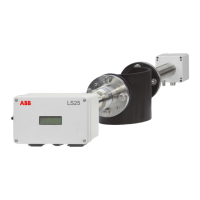16 AO2000-LS25 LASER ANALYZERS | OI/AO2000-LS25-EN REV. D
… 2 Use in potentially explosive atmospheres in accordance with ATEX and IECEx
… Use in ATEX / IECEx Zone 2
Ex nA nC tc
The basic protection type is “n”. This type of protection is
used for equipment that is not able to ignite an ambient
hazardous atmosphere during normal operation.
“nA” is applied to non-sparking equipment, i.e., equipment
designed to minimize the risk of occurrence of sparks that
may create an ignition hazard under normal operating
conditions.
“nC” is added because there are relays in the device which are
hermetically sealed. “tc” means that the dust protection is
the housing.
[op is Ga/Da]
The laser radiation emitted by the device is considered non-
incendive and thus allows Zone 0 or Zone 20.
IIC/IIIC – Gas / dust group
No limitation to specific gases / dusts.
T4 / T100°C
Specifies the maximum surface temperature outside the
device.
EPL Gc (Zone 2) / EPL Dc (Zone 22)
An area where flammable concentrations of flammable
gases, vapors or liquids or ignitable dusts are unlikely, and if
they occur, then only sporadically and over a short period of
time
Special operating conditions
• Possible danger of electrostatic discharge. The safety
instructions in Operating instructions on page 21 must be
observed.
Ambient conditions
Operating temperature
−20 °C to +55 °C
Storage temperature
−20 °C to +55 °C
IP rating
Designed for outdoor applications (all IP 66-certified
modules)
Degree of contamination
2
Installation category (overvoltage category)
II
Installation height
2000 m
Air humidity
0 to 95 %
Device data
Laser classification
Class 1 according to IEC 60825-1
Class 1M according to IEC 60825-1*
* All O
2
analyzers supplied after October 2017
ENOHD
For O
2
analyzers: 7.88 m
NOHD: Nominal Ocular Hazard Distance
Eye safety distance is the distance at which the irradiation level
or irradiation is equal to the corresponding exposure limit of the
eye’s cornea.
If the eye safety distance also includes the possibility of viewing
with optical aids (e.g. telescope), we refer to the extended eye
safety distance (ENOHD: Enlarged Nominal Ocular Hazard
Distance).

